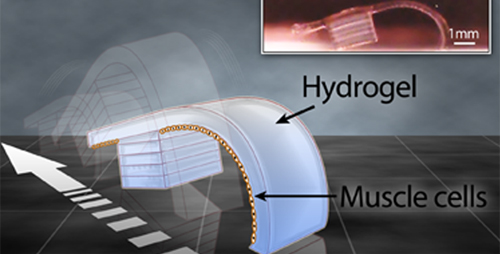At the University of Illinois Urbana-Champaign, biological engineers have created what is becoming known as a “bio-bot.” It’s neither a cyborg nor an android, and it can fit on the face of a dime. What makes it special is that it can walk independently: that is, without the help of any mechanisms or electronic parts.
The secret of the bot’s locomotion lies in the power of nature. The structure itself has two legs: a short, solid one for stabilization and a long one made of soft hydrogel. The long leg is covered in rat cardiac cells, which pulse as a good rat’s heart should. As the cells pulse, the leg contracts and expands, scooting the body forward. As long as the cells keep pulsing, the bot keeps moving. If you’re having a hard time visualizing exactly how this works or what it looks like, the image below (courtesy news.illinois.edu) and this video should help clear things up.

Obviously, the bio-bot can’t be very large if it can be propelled by cells: indeed, it’s only seven millimeters long. But the implications for the little bot are powerful. Most importantly, it moves using only biological parts. This means it needs no fuel source save food for the cells. Also, the main body can be easily created using a 3D printer. Since 3D printers rely on computer-based blueprints, this fact has two important meanings: first, that it can be easily and inexpensively replicated; and second, that the design can be tweaked and modified for optimization despite its minuscule size. This was especially useful in the development stage, where the researchers tried several barely dissimilar prototypes to discover the best proportions for the bio-bot.
 Rashid Bashir(left, courtesy of UIUC), the University of Illinois professor who headed the project, sees the bio-bots as a new interface between biology and engineering, where engineers can tap into nature’s resources and solutions to solve societal problems. In the case of this project, he sees an application in the fields of drug screening or chemical analysis. Since cells behave differently when exposed to different chemicals, bio-bots could act as multifunctional sensors. Says Bashir in a UIUC article:
Rashid Bashir(left, courtesy of UIUC), the University of Illinois professor who headed the project, sees the bio-bots as a new interface between biology and engineering, where engineers can tap into nature’s resources and solutions to solve societal problems. In the case of this project, he sees an application in the fields of drug screening or chemical analysis. Since cells behave differently when exposed to different chemicals, bio-bots could act as multifunctional sensors. Says Bashir in a UIUC article:
“Our goal is to see if we can get this thing to move toward chemical gradients, so we could eventually design something that can look for a specific toxin and then try to neutralize it...Now you can think about a sensor that’s moving and constantly sampling and doing something useful, in medicine and the environment.”
The lab’s next step will be to utilize this sensor capability and produce bio-bots that can move toward or away from chemical and light-based stimuli. Also planned are bots with varied shapes that can climb slopes or steps.
This groundbreaking project was supported by the NSF through a Science and Technology Center grant. For more information on the grants and funding awarded to researchers and projects at the University of Illinois Urbana-Champaign, click the following button:
The University of Illinois will be home to Biotechnology Calendar’s Urbana-Champaign Bioresearch Product Faire™ on May 1st, 2013 and the Chicago BioResearch Product Faire™ the following day. These provide a great opportunity for life science researchers, purchasing agents, and laboratory product vendors to network and discuss laboratory techniques and technologies. Biotechnology Calendar, Inc. has been bringing life science research trade shows to top research campuses for 20 years now. If these shows sound like a good fit for you, click the button below. If you’d like to attend a show closer to home, please see our 2013 schedule.



